
This article originally appeared in the September/October 2016 issue of Museum magazine.
For people with autism and other sensory processing disorders (SPDs), visiting museums and other public sites can be a difficult experience. A variety of factors may limit their social experiences and isolate them from their communities. Museums can be loud, crowded, and over-stimulating to individuals with SPDs. These individuals and their families face the possibility of negative reactions from others, which can lead to anxiety and distress. As a result, they miss out on opportunities to engage with others around culturally relevant topics, go on outings with family and friends, and practice language, communication, social, and physical skills that are typically practiced in school or other controlled environments.
Some museums have created early morning programs designed for families of children and adults with SPDs, including Autism Spectrum Disorders (ASD). Earlier this year, the Alliance, in collaboration with the AAM Education Professional Network (EdCom), hosted a workshop at the Walters Art Museum in Baltimore based on the Walters early morning program, Sensory Morning. Participants explored this program and learned about similar programs at the Intrepid Sea, Air & Space Museum in New York City and at the Smithsonian Institution in Washington, DC. Representatives from the Walters, Intrepid Museum, and the Smithsonian Accessibility Program briefly describe their respective programs, touching on development and structure, goals, successes and challenges, lessons learned, and next steps. The programmatic approaches at the Walters, Intrepid Museum and Smithsonian vary, yet all three offer welcoming, developmentally appropriate learning opportunities for children and adults of all levels and abilities. Each institution proactively seeks input from this community when developing programs and resources. Each institution provides thoughtful previsit materials to ensure that families are comfortable and confident. All three institutions train staff and volunteers on how to meet these visitors’ needs. And each institution regularly evaluates programs to continually improve their offerings and to seek potential resources for programming.
Sensory Morning at the Walters Art Museum
By Rebecca Sinel
“It was so nice to be someplace where people understood that Matthew has different needs and has different reactions to things. It was great to have so many ways to engage him.”
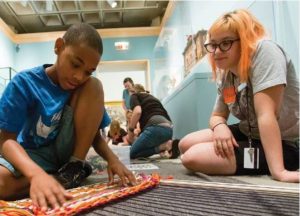
Since 2010, the Sensory Morning program has helped the Walters Art Museum uphold its founders’ goal for the institution: to be for the “benefit of the public.” This free program invites visitors with SPDs and other sensory-based needs to enter the Museum before public hours. Our goal is to promote skill-building through social interaction, exploration, and play in an environment that is welcoming and free of judgment. When families arrive for Sensory Morning they are greeted by museum educators, receive a program of activities and fidgets, (toys to distract them) and have the opportunity to review Social Stories, first-person narratives to help prepare for the day’s events. Each Sensory Morning program relates to a collection area and includes multi-modal activities designed to engage diverse learners. We invite visitors to participate in thematic, sensory-based stations, where they can explore specific art, artists or periods; create art projects using different media, skills and techniques; practice yoga; or take a sensory break in a dimly lit area filled with weighted vests, headphones, tunnels, parachutes, books, and other quiet resources. Families move throughout the spaces at their leisure. They can choose from a variety of activities based on what interests them and best supports their learning needs.
Several critical aspects make Sensory Morning accessible for our visitors. Registered participants gain comfort and confidence in attending the program through personal communication with museum staff during the registration process. Attendees have noted their appreciation for the free admission, particularly as many of them pay for costly occupational, physical, or speech therapy services. By starting the event before public hours, there is less worry about loud, crowded spaces. Staff, including educators and security officers, is prepared beforehand about the types of behaviors to expect so they can engage families in a positive, friendly manner.
While we design curriculum with children with SPDs in mind, we welcome all ages and developmental levels. Our attendees often tell us they must split activities when visiting other museums; for example, a parent might take her child with autism to one program while her spouse takes their other child elsewhere. At Sensory Morning, families value the opportunity to have quality time together and to feel part of the Baltimore community. Once the Museum opens to the public, anyone is able to participate in the gallery and studio activities; no one is turned away, even if they do not identify with the SPD community or if they didn’t register for the program. By including a diverse group of learners, we are able to foster compassion and empathy among visitors, while providing the opportunity for typically developing children to model skills and behavior for their peers.
A key component of our success is the strategic partnership between the Walters and Kennedy Krieger Institute’s Center for Autism and Related Disorders (CARD), which was formalized in 2015. CARD provides clinical and therapeutic services for children with ASD. At the Museum, the center’s occupational therapists and speech-language pathologists train staff and work alongside educators to facilitate Sensory Morning’s gallery and studio experiences.
The Walters has increased its capacity to address visitors’ needs, both during Sensory Morning and regular operating hours, thanks to CARD’s training sessions, input on activities and resources, and their help in advertising programs.
Museum-wide support for Sensory Morning has allowed us to increase the program’s frequency from one to four times per year. We look forward to seeing the many dedicated families who return for each Sensory Morning program. While this is a testament to our success, we strive to reach new audiences and are always looking for new ways to promote the program. Additionally, we plan to make resources such as fun packs filled with fidgets, wiggle seats, gallery activities, and books, available during general Museum hours so all visitors can benefit from them. As we look to the future of accessibility initiatives at the Walters, Sensory Morning will serve as a model for engaging diverse learners. Our hope is that this program is a stepping stone for families to feel comfortable visiting the museum on any day, at any time.
Early Morning Openings at the Intrepid Sea, Air & Space Museum
By Charlotte Martin
The Intrepid Sea, Air & Space Museum centers on the former Navy aircraft carrier Intrepid, a National Historic Landmark. Its wide-ranging collections also include the submarine Growler, British Airways Concorde, and space shuttle orbiter Enterprise. The museum is an immersive experience; as such, it presents both opportunities and challenges for fully welcoming visitors with autism and their families. In 2012, the museum’s access team piloted a free program focused on this audience. Early Morning Openings allow families with children with autism (ages 3 to 17) to experience the museum through a structured yet flexible program. Eight times annually, 40 to 100 children and adults enjoy the museum without the crowds and noise that typically fill the historic steel ship.
All programs are led by museum education staff members, who are supported by a volunteer occupational therapist and specially trained teen interns. Themes vary throughout the year and include learning goals specific to the theme—such as the science of flight or how life on a ship compares to life on land. These supplement the program’s overarching social-emotional goals, which are to develop social skills and improve problem-solving and flexibility in new environments. Variations in theme can appeal to different families and encourage attendees to come to multiple sessions. Many families bring children who span a wide age range and may include neurotypical
siblings.
Before each Early Morning Opening, educators email registered families a visual vocabulary, schedule and an illustrated social narrative, which is a first-person preview of the entire experience from arrival and going through security to finishing the program. The resources help families set expectations and can help reduce anxiety about a change in daily routine. The combination of text and photographs helps support multiple ways of processing and communicating information, particularly important to people with SPDs.
Skip over related stories to continue reading articleWhen families arrive, they receive nametags and a copy of the visual vocabulary and schedule. They can then take part in an activity to fill the time before their guided exploration begins and to help them “get into character” for the morning’s theme. For a program on astronauts, for instance, children may design their own “mission patches,” emblems that astronauts and other team members wear when working together on a mission. Based on feedback from families, educators have started incorporating checklists for the day into these craft and design challenges. For example, the patches include a “mission checklist” on the back, and children receive stickers they can use to note that they have completed various activities.
All of our guided explorations include multisensory experiences and multiple opportunities to understand and communicate ideas. In an aviation program, families learn how airplanes fly by moving their bodies like planes and feeling the rivets that aircraft together. Families work together to fold paper airplanes in an assembly line or match tools. For programs about life aboard the ship, families might look at menus from the ship’s service and smell spices used in the meals. When exploring tight spaces where it is difficult for educators to engage with the entire group, families use scavenger hunts and matching games to enhance their experience. In addition, one educator always leads an equitable experience that avoids the challenging space.
At the Intrepid Museum, if children are fidgety or demonstrate limited self-regulation skills, educators offer them small fidgets, such as Tangles stress-relieving toys that they can play with and not disrupt others. Educators also carry noise-reduction headphones in case a child becomes over-stimulated by the environment. If a child starts to wander off, parents appreciate knowing that there is no crowd to get lost in or unguarded exits through which to disappear. If a child needs a break, a trained staff person or volunteer can offer additional resources or walk the family to the sensory-friendly quiet room that is set up in the museum’s Education Center.
Most programs also include the opportunity to meet an expert related to the day’s theme, such as a former crewmember of Intrepid, a staff aircraft restoration specialist, or a civilian astronaut. These volunteers bring photographs and touchable objects for children to explore. Visual prompt cards help engage children who are shy or non-verbal.
The programs conclude in the Exploreum Interactive Hall, which remains closed to the public for an additional hour. Staff stationed at tables throughout the space lead activities that connect to and expand on elements of the guided exploration. Children may fold and test paper airplanes, launch straw rockets, create clay meal trays, or make a postcard that the museum will mail to anyone in the country. Visual instructions accompany all activities so families can work at their own pace. Participants may also play in and explore the interactive and immersive exhibits in the Exploreum. At 11 a.m., the museum opens to the public, at which point families are welcome to continue exploring or to depart. Afterward, we ask families to provide feedback that educators will apply to future programs and share with funders.
Since the founding of the program, the museum’s Autism Advisory Council has been and continues to be an important partner in these programs. The council meets quarterly, and active participants receive a family membership to the Museum. Parents on the council provide candid feedback, review resources, and have been powerful advocates for a more inclusive museum and menu of programming. Educators are also proud to have worked with a talented and passionate cohort of teen interns who volunteered for special training to work with people with disabilities.
Looking ahead, the museum’s access team is working with other departments to ensure that it offers a continuum of experiences for visitors with autism and other disabilities. This includes providing more online and on-site resources and developing best practices for inclusive public programs. As Early Morning Openings attract a large number of families that primarily speak Spanish, educators also are working to add multilingual opportunities to the programs.
Morning at the Museum at the Smithsonian Institution
By Ashley Terrell-Rea
In 2009, the Smithsonian Accessibility Program and Smithsonian educators began receiving requests for information from families who wanted to visit the museums but had concerns about how their children with autism would react. We began to explore programs outside the Smithsonian but discovered that there were few programs that addressed these families’ needs. As a result, we formed a community advisory committee (CAC) comprising special education teachers, museum educators, therapists, parents, and advocates to create museum programs for families of children with autism. Over the next year and a half, the CAC narrowed its focus to three areas: training curricula for staff, docents, and volunteers specific to visitors with autism web-based pre-visit materials including social stories, sensory maps, picture schedules, and visit tips for these families Morning at the Museum, which offers early admission to a Smithsonian museum every other month In 2011, we conducted a prototype of Morning at the Museum with seven families at the National Museum of American History (NMAH). In conjunction, the CAC collaborated with University of Maryland researchers to evaluate the pre-visit materials, “take a break space,” and families’ experience at the event. Based on participants’ feedback, the CAC and researchers determined that the program provided a positive experience for families and that pre-visit materials are useful if they are adequately advertised and adaptable to individuals’ needs.
“We really appreciate these programs because of how kind and flexible everyone has been. It makes all the difference. As a family, we get tired of the dirty looks and sighs from adults at various places when our child gets upset or needs to pace around to regulate. I wish more people did what you do.”
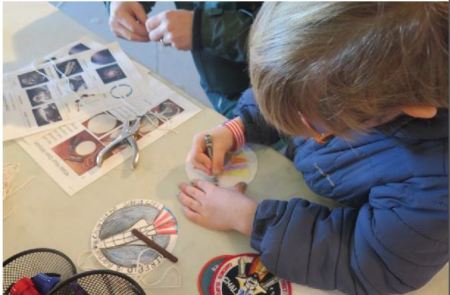
As of June 2016, Morning at the Museum events have taken place at five Smithsonian museums—with plans to add two more—as well as at the National Zoological Park and the Smithsonian Folklife Festival. For each Morning at the Museum, appropriate pre-visit materials are available online for participating museums and are sent to families to help them prepare for the event. Families arrive at the museum an hour before it opens to the public. They then participate in sensory, movement, and kinesthetic activities related to particular exhibitions. A “take a break space” is provided.
After each event, the CAC collects feedback in a short survey comparing attendees’ Morning at the Museum experience with previous museum visits. On average, families rate their past experiences at other museums as a 5.2 out of 10 (1 being very difficult and 10 being very positive), indicating that many have experienced difficulties visiting these museums. For the Morning at the Museum event, however, families averaged a rating of 9.8.
Morning at the Museum continues to grow and we continue to receive positive feedback. The CAC’s original target audience was families of children with autism ages 6 to 12. However, children and teens with cognitive disabilities, SPDs, and other medical conditions have attended our events with success. The CAC plans to develop programs for young adults to practice socializing with peers and to develop an appreciation of museums.
Despite our growth, we continually must contend with minimal resources, inconsistent volunteer participation, and staff turnover. Aside from two full-time staff members in the accessibility program, the remaining CAC members are volunteers. At the same time, the increased number of participating Smithsonian museums equates to a growing demand for pre-visit materials and programs. To address these challenges, we plan to develop a new recruitment stream for volunteers at the Smithsonian and in the community. We also plan to increase the number of Morning at the Museum events to 12 per year in as many museums as possible.
Morning at the Museum has impacted multiple departments throughout the Smithsonian and has sparked ideas for new programming. Staff members report that participating in the planning of Morning at the Museum or volunteering at an event has inspired creativity and encouraged them to incorporate some of the materials and strategies into other youth and family programs. Smithsonian staff members are more cognizant of the facility and exhibition design implications of serving visitors who are neurodiverse. As a result, the accessibility program is conducting research and plans to update the Smithsonian Guidelines for Accessible Exhibition Design. These examples demonstrate the impact that Morning at Museum and other inclusive programs can have on staff and in the community.
AAM Accessibility and Inclusion Resources and References
A key focus area of the AAM 2016-2020 Strategic Plan is diversity, equity, accessibility, and inclusion. aam-us.org/about-us/ strategic-plan, This fall, AAM is offering a webcast series on inclusive hiring practices. aam-us.org/ resources/online-programs, The AAM Recorded Webinar Library contains archived programs related to access, inclusion, equity, and diversity. aam-us.org/resources/ online-programs, Several recent Museum magazine articles have focused on diversity, inclusion, and accessibility. Search the archives at aam-us.org/resources/publications/museum-magazine. Recent issues of The Exhibitionist (now Exhibition) have focused on inclusion and universal design. aam-us.org/resources/publications/exhibition, Review the AAM Diversity and Inclusion Policy Statement. aam-us.org/about-us/ strategic-plan/diversity-and-inclusion policy, The AAM Resource Library features information on accessibility and universal design in the Education and Interpretation, and Facilities and Risk Management sections.aam-us.org/resources/resource-library, AAM Professional Networks focus on related aspects of museum practice, including Diversity (DivCom), Education (EdCom) and the National Association for Museum Exhibition (NAME). Learn more at aamus.org/resources/professional-networks.
Greg Stevens is assistant director for professional development at AAM. Rebecca Sinel is the manager of family programs at the Walters Art Museum in Baltimore. Charlotte Martin is the museum educator for access programs at the Intrepid Sea, Air & Space Museum in New York City. Ashley Terrell-Rea is program specialist in the Smithsonian Accessibility Program in Washington, DC.




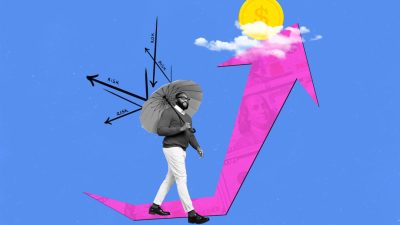
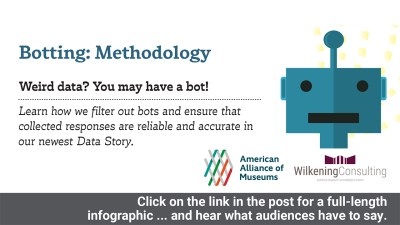

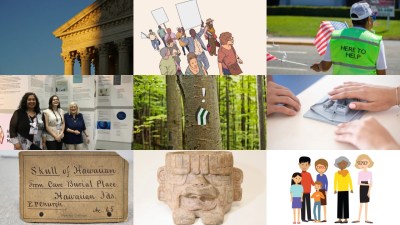
Comments